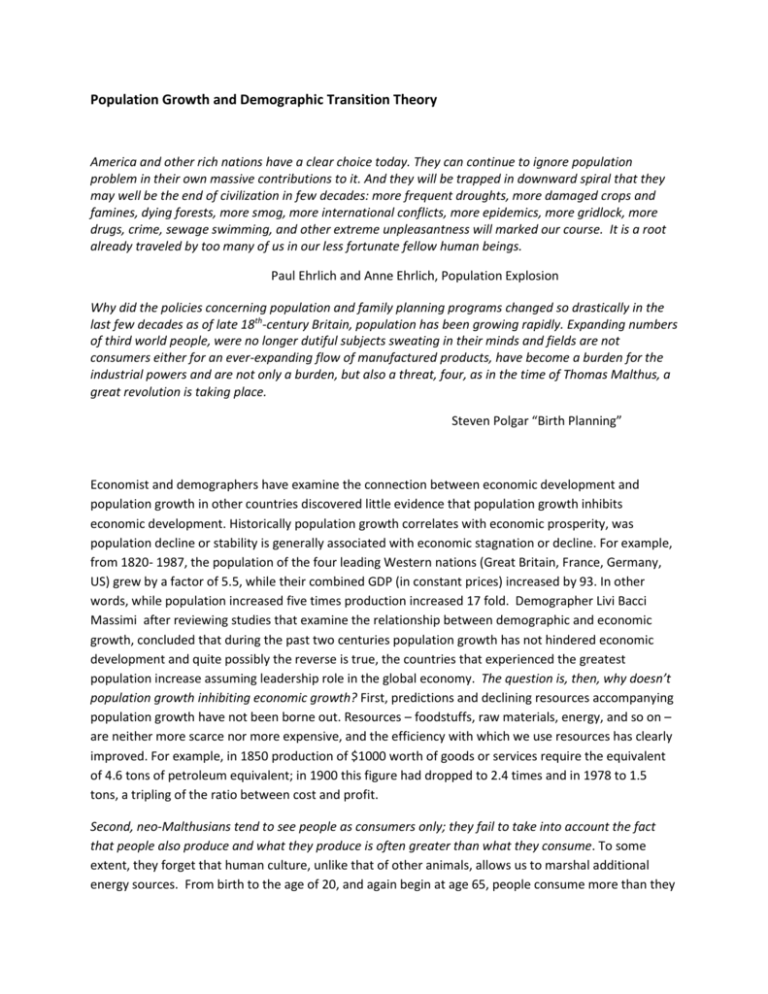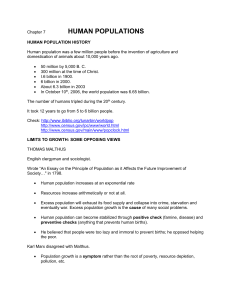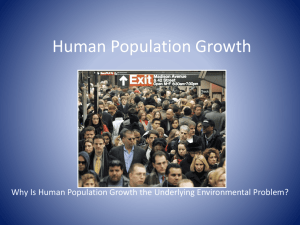Demographic Transition Theory
advertisement

Population Growth and Demographic Transition Theory America and other rich nations have a clear choice today. They can continue to ignore population problem in their own massive contributions to it. And they will be trapped in downward spiral that they may well be the end of civilization in few decades: more frequent droughts, more damaged crops and famines, dying forests, more smog, more international conflicts, more epidemics, more gridlock, more drugs, crime, sewage swimming, and other extreme unpleasantness will marked our course. It is a root already traveled by too many of us in our less fortunate fellow human beings. Paul Ehrlich and Anne Ehrlich, Population Explosion Why did the policies concerning population and family planning programs changed so drastically in the last few decades as of late 18th-century Britain, population has been growing rapidly. Expanding numbers of third world people, were no longer dutiful subjects sweating in their minds and fields are not consumers either for an ever-expanding flow of manufactured products, have become a burden for the industrial powers and are not only a burden, but also a threat, four, as in the time of Thomas Malthus, a great revolution is taking place. Steven Polgar “Birth Planning” Economist and demographers have examine the connection between economic development and population growth in other countries discovered little evidence that population growth inhibits economic development. Historically population growth correlates with economic prosperity, was population decline or stability is generally associated with economic stagnation or decline. For example, from 1820- 1987, the population of the four leading Western nations (Great Britain, France, Germany, US) grew by a factor of 5.5, while their combined GDP (in constant prices) increased by 93. In other words, while population increased five times production increased 17 fold. Demographer Livi Bacci Massimi after reviewing studies that examine the relationship between demographic and economic growth, concluded that during the past two centuries population growth has not hindered economic development and quite possibly the reverse is true, the countries that experienced the greatest population increase assuming leadership role in the global economy. The question is, then, why doesn’t population growth inhibiting economic growth? First, predictions and declining resources accompanying population growth have not been borne out. Resources – foodstuffs, raw materials, energy, and so on – are neither more scarce nor more expensive, and the efficiency with which we use resources has clearly improved. For example, in 1850 production of $1000 worth of goods or services require the equivalent of 4.6 tons of petroleum equivalent; in 1900 this figure had dropped to 2.4 times and in 1978 to 1.5 tons, a tripling of the ratio between cost and profit. Second, neo-Malthusians tend to see people as consumers only; they fail to take into account the fact that people also produce and what they produce is often greater than what they consume. To some extent, they forget that human culture, unlike that of other animals, allows us to marshal additional energy sources. From birth to the age of 20, and again begin at age 65, people consume more than they produce. Between the ages of 20 and 65, people produce more than they consume; that is, they contribute more to the economy than they detract from it. This means that life expectancy of a population increases, the excess of production or consumption will also increase; that is, there is an excess in consumption when life expectancy was 20 or 30 years, whereas a life expectancy of 40 years, output exceeds consumption. Members having life expectancies of 50 years or more produced the greatest excess of production or consumption, this corresponds to the so – called economic take – off of several countries, including England, Wales, Sweden, Japan. Production and Consumption by Age Age 0 -- 1 1—5 5-10 10-15 15-20 65-70 70-75 75-80 80+ Excesses in consumption 50 225 332 450 350 350 400 500 600 Age 20 – 25 25 – 30 30 – 35 35 – 40 40 – 45 45 – 50 50-- 55 55--60 60 -- 65 Excesses in Output 260 300 350 350 320 290 260 215 85 The third reason why population increase may not lead to economic decline is because of the economics of scale; benefits of resources multiply by their use. For example a road’s usefulness is related to how heavily traveled; because its function is to help trade, increase education, created large market, more people use it the more benefit it creates. For education is thought to stimulate growth, it follows that once schools are created, more people attend them more benefits will accrue. Increases in population may make existing resources, such as roads, schools, factories, and hospitals more economically profitable. Fourth, because consumption of commodities is what drives a capitalistic economy, more people there are, the greater, theoretically, is the demand for goods and services. Finally human population growth can serve as stimulus to agricultural and technological innovation. In agricultural societies as population increases people will far more territory, farm the same territory more often, and use new technology such as plow or irrigation, producing more food to support growing population. In conclusion, there is little evidence to indicate that economic growth is slowed by population increases this doesn’t mean there is no relationship, only that evidence linking economic growth with populationas far too tenuous to account for alarms that Malthusians and neo-Malthusians have raised. The Issue of Carrying Capacity Biologists use the term carrying capacity to denote maximum number of organisms a government environment will support. For example, we can examine the types of food to sustain wolves in specific environment and, by calculating how much of that food is available, estimate the number of wolves environment will support. This is the kind of assumption Malthusians make about the human population: given food and other resources on the planet, how many people can survive before those resources are depleted? For example, David Pimentel estimate that, because of declining fertile land, declining water resources for irrigation, and declining fertilizer usage, by the year 2100 to world will be able to support a population of 2 billion people living on a standard half that of the US in the 1990. The problem with applying the theory of carrying capacity of human beings is our capacity for culture and symbolic thought enables us constantly to alter our diets and the way we exploit environment for food. When a gathering and hunting people exceeded the population of a given area could support and were restricted from migrating to another area, they began to plant and harvest their own plants and breed their own animals. Human beings are capable of constantly changing the rules of subsistence by altering their resource base. In fact, estimates of the Earth’s carrying capacity vary widely, or 7.5 billion 247 billion, depending on the technology employed to produce food. Population growth was not, for Thomas Malthus, the major issue. What concerned him was a rising number of poor in England, why they should exist, and what should be done about them. Poverty, according to Malthus, was not a consequence of expanding industrialism, and closer law that evicted people from common lands, where the need to manufacturers for source of inexpensive labor; it arose from the laws of nature, the discrepancy between the powers of reproduction and the ability to expand food production. People were poor because there were too many of them and because they kept having children in spite of their poverty. Providing relief to the poor would simply encourage them to have more children. Instead they should be forced to delay marriage (he was opposed all forms of birth control). Malthusian position assumes that poverty exists it must be because of overpopulation, which is the fault of those people who, because of a lack of moral standards, refused to change their reproductive behavior. There are also may have been in the Malthusian position of fear that the army of the poor gathering in cities such as London and stimulate revolution, much as they did in France in 1787. (So the fear is around having a lot of poor people and the potential for revolution) Marx, saw poverty not as a consequence of excess population but as a condition produced by the capitalistic mode of production, which required a surplus of labor and “industrial reserve army” condemned to compete for wages, with the losers doomed to unemployment and underemployment. It is their exclusion or partial exclusion from the economy and their dependence on wage labor, not their numbers, said Marx, which determined their impoverished condition. Demographic Transition Theory World population growth increase very slowly from human beginnings to around 1750. This relatively steady state of population growth and maintain largely because of high birth rates were offset by high death rates. Toward the end of 18th century and beginning of 19, totality began to decline in developed countries because of advances in medicine and sanitation, whereas birthrates remain the same; consequently, population rose rapidly. Then, because population pressures and availability of contraception, birth rates decline to close to “replacement level” and rate of population growth stabilize, at least in developed countries. Population rise in periphery came later, beginning in mid-20th century, but particularly explosive because mortality rates were reduced much more quickly than they had been in core countries, especially among children. Fertility rates in the periphery, according to demographic transition theory, are only now beginning to decline in response to population growth. This occurs when increasing costs of education and childcare and modernization societies, along with the availability of modern forms of conscious action, provide incentives and means for people to reduce their family size. Demographic transition models shares with assumptions with Neo-malthusians in theory; it, too, links lowered fertility with economic development. Instead of arguing economic development requires lower fertility, demographic transition there is suggests lowered fertility will result from economic development. Problem with this is to make some ethnocentric assumptions. First, it assumes that throughout history fertility rate of always been uniformly high. High fertility rates were necessary, reason there is, balance the number of deaths that occur because of harsh living conditions of preindustrial peoples. Yet there was clearly and at the center bias in this assumption; although theorists recognize fertility rates among preindustrial European vary depending on the age at which marriage occurred, they assume the preindustrial non--- Europeans would not or could not control their fertility rates. Second, demographic transition model assumes only way of stabilizing population growth to make available Western methods of birth control and contraception. The model significantly ignores variations in fertility that are based on various economic and social factors as well as the fact that preindustrial populations were significantly healthier than we give them credit for. Third, it assumes the resistance of people in poor countries to adopt the Western standards of fertility is result of irrational thinking, outmoded religious values, or traditional or fatalistic worldviews. Fertility control, in contrast, is consistently viewed as rational and modern. Demographic transition theorists blame high population growth in the periphery on the people themselves, arguing that capitalist expansion, rather than causing the problem of population growth, can cure it. In other words, the model sees economic development as an answer to the problem; Marx viewed economic development as a cause. Theorists ignore the fact that human populations have consistently adjusted fertility rates to local economic and social conditions. High fertility rates are not the result of ignorance, outmoded religious values, or lack of education but the result of social or economic factors that people, largely women, react to in order to adjust the size of their families. A Primer on the Determinants of Population Growth and Decline At its simplest, worldwide population growth is a factor of only two things – births and deaths. If the rate of death is lower than the rate of birth, population increases in it – if deaths exceed births, population declines. In regional populations migration also contributes to population increases or declines, question is what economic, social, and cultural factors dictate birth and death rates? Stage 1 Stage 2 Stage 3 Birth Rate High High Low Mortality Rate High Low Low Population Growth Stable Accelerated Stable Fertility Birthrates are a factor of number of children born in the given population; this is determined by biological and social factors including frequency of births during a woman’s fecund period, and portion of the fecund period – between puberty and menopause – used for reproduction. Frequency of births – the interval between births – determined by a number of factors, including the following. Period of infertility after birth: there is a period after birth when ovulation does not occur. Time between ovulation and conception: although some women may concede during the first ovulation after giving birth, others do not. The average is 5 to 10 months. Average length of pregnancy (nine months) Fetal mortality: about one in five recognized pregnancies end in miscarriage. (Actual percentage of interrupted pregnancies, including those that are unrecognized, may approach 80%) Presence or absence of birth control techniques. Of these factors the length of time between births and presence or absence of birth control techniques provide for most of variation in birth rates. Length of time between births can be influenced by various cultural factors. For example, breast-feeding suppresses ovulation. In society children are not weaned until age of three, four, or five years, breast-feeding leads to greater intervals between births. Attitudes towards breast-feeding very significantly: in some societies it is encouraged and expected in others it is discouraged. Economic and consumption patterns may also influence breast-feeding. For example, breast-feeding in the periphery has decreased in the past 30 to 40 years because of increased advertising and sales of powdered infant formula. So cultural or social factors that inhibit breast-feeding, especially in the absence of modern birth control methods, may result in shorter spacing between verse and increase in fertility and population growth. A second major factor infertility is the fecund period used for reproduction, or the number of years in which a woman can conceive. This, too, various considerably because of cultural, social, or economic factors. Biological fecundity isn’t. Shortly after the onset of menses until the onset of menopause; this can range from 11 years of age to over 50 years of age, although the average is 18 years of age to 40 years of age. More important is cultural fecundity, the age at which a woman becomes sexually active. This is determined in most societies by age at marriage, which varies on average, from 15 to 25 years of age. Assuming a 15 year reproductive, (fecundity lasting from age 25 to age 40) with a maximum interval between births produces a fertility rate of 4.3 children per woman: Death. Most important is the percentage of reproductive realized in life expectancy ranges. For example, in population with a life expectancy of 20 years, the number of women who live to their full reproductive period is far less in a population with a life expectancy of 60 years. In fact demographers have calculated that with a life expectancy at birth in 20 years, only 29.2% of potential reproductive, whereas with a life expectancy of 80 years, 98.2% up potential fecund period is lived. Most demographers have assumed that mortality rates in preindustrial societies were consistently high, but that is probably mistaken. It seems we have consistently underestimated the general health levels of preindustrial societies. The other major mortality factor in population growth is infant mortality, especially because this is where greatest variation in life expectancy rates occur. It’s also an area in which control on population growth can be exercised with practice of infanticide and abortion. For example one factor in death rates may be preference for male or female children, preference that may be determined by economic needs. In societies that practice traditional agriculture there is evidence that boys and girls are equally valued as farm workers. In the early industrial society, when labor began to be more prevalent, there was a preference for boys, a preference that gradually began to subside as women enter the factory workforce. Migration Migration is another factor in population growth rates. Although migration may not appear to influence world population, they can influence of regional patterns of population growth and decline. Her example migration can affect reproductive rates: population to which in which many people migrate may feel reduced population pressure, which may result in earlier marriages and rising birth rates. If more men migrate, fewer women may marry, causing the birth rate to decline. Migration rates may in turn be affected by cultural factors: in agricultural areas that practice impartable inheritance, in which land is passed on undivided to an older or younger child, those who do not inherit are more likely to migrate out; in agricultural societies that practiced pardonable inheritance, in which land is divided among some or all children, people are less likely to leave. The First Demographic Transition What are the assumptions of transition theorists is that pre-agricultural people suffered from high mortality that was balanced by correspondingly high fertility to keep the population from dying out. We know from archaeological evidence and research among gatherers and hunters and population growth rates before 10,000 BC were slow. However, chemical and anthropometric analysis of skeletal remains reveal that gathers and hunters have fewer health problems than later agricultural and industrial peoples, and at the rate of infant mortality was comparable to or well below that of European rate up to the 19th century and below those of peripheral countries through the mid-20th century. Moreover a life expectancy was relatively high, around 30 years – higher than some 19th century Western countries and higher than that in many peripheral countries….. gatherers and hunters do have a lower fertility rates than sedentary neighbors, research shows that their fertility levels increase when they settle. The French Canadians People have not only been able to maintain low fertility levels but they have also been able to increase their rate of growth. In the 17th century 15,000 people migrated from France to what is now Québec; in 100 years from 1684 to 1784, the population grew from 12,000 to 132,000 – an 11 fold increase representing an annual growth rate of 2.4%. Because only one third of the original settlers established families, it’s estimated that the vast majority of the current 8 million French-Canadians are descended from some 1425 women. The demographic success was due not to declining death rates are too high birth rates resulting from early marriages. Probably because of a higher proportion of males in the population, women married at ages 15 to 16; unlike women in France, Wales and Québec had little trouble remarrying and consequently giving birth to more children. Women in Québec averaged only 25 months between pregnancies, compared to 29 months in France. Finally there was a lower mortality rate and a life expectancy five years greater in Québec than in France, because low population density Down the spread of disease. Of the Québec pioneers who began families each couple had 6.3 children, of whom 4.2 married; consequently the population doubled in 30 years. The 4.3 children of each family in turn produced an average of 34 offspring. That is, each original couple had more than 50 children and grandchildren. Moreover daughters of pioneers had even higher fertility rates than their mothers and grandmothers, those marrying between 15 and 19 years of age adding an average of 11.4 offspring compared to 10.1 for the original pioneers marrying between the ages of 15 and 19. The fertility rate of French Canadians in the 18th century is among the highest ever recorded. Some people assume religion was a factor in fertility of Québec women; however, today, with solecisms still dominant religion in Québec as it was in 17th and 18th centuries, the province has one of the lowest birth rates in the world. The Case of Ireland At beginning of 18th century population growth in Ireland was relatively low. People married later, reducing the reproductive period, and mortality was high, life expectancy generally being under 30 years. Then from 1782 1840 the population doubled, and 4 million to more than 8 million. There seems little doubt that reason was that women began to marry earlier, between ages 15 and 20, and some areas and younger. Marriages in Ireland were arranged but only when the prospective bride and groom had access to land and farm. Before the late 18th century, marriage was at a relatively late age – between 20 and 25 years for women – because there is not enough land to support early marriage. Two things happened that increase the availability of land and encouraged earlier marriages. Virtually all farms in Ireland were owned by British landlords, who extracted rents from the tenets. Their profits rose when a new land holding was created so they had a vested interest in increasing the number of farms. In addition population was rising in England in the late 18th century increasing demand for food, particularly corn. Landlords who increased their number of farms and the amount of land devoted to corn production could realize greater profits. As a result of landlords subdivided farms into smaller and smaller plots, reclaim swamps, and extended farming into mountainous areas. Families were able to subsist on smaller plots of land than before because of the potato. Potato cultivation is very productive: an acre of potatoes can feed a family of six, including their livestock. A barrel of 280 pounds of potatoes can feed a family of five for a week at a daily consumption rate of 8 pounds per person. Estimates are that people ate about 10 pounds a day, which along with a liter of milk, would provide some 3800 calories along with all necessary nutrients. This allowed landlords to divide land into smaller parcels, providing greater number of farms. From 1791 to 1831 amount of agricultural land increased, wears a size of individual farming plots became smaller. The result was an increase in the number of farming plots permitted people to marry earlier, resulting in a rate of population increase of greater than 1% per year. In 1845 the potato fungus struck destroying the harvest of 1846 entirely leading to the great famine of 1846 – 1847. This and epidemics resulted in 1.1 million to 1.5 million deaths and an exodus from Ireland of 200,000 people per year. The average age at marriage increased from 23 to 24 between 1831 – 1841 to 27 to 28 by 1900, and 1/5 of the population never married. As a result the population of Ireland decreased from 8.2 million in 1841 to 4.5 million in 1901. The cases of the gatherers and hunters, Québec pioneers, and Irish peasants reveal that contrary to assumptions of transition theory, populations historically adjusted their fertility rates when they needed to adapt to local social and economic conditions, and they did so without the benefits of modern contraception. Wealth Flows Theory It’s clear that people, particularly women, can and do adjust fertility in response to local economic and social conditions and they do so without assistance of Western methods of contraception. Yet fertility rates, while dropping in some countries, root remain high in most the question is why does demand for children in developing countries remain high? The cost of raising children in rural areas is low, and in terms of cost children may represent a net gain economically For security in old age. Surveys in Indonesia the Korea, Thailand, Turkey and Philippines reveal that a beat to 90% of parents expect economic assistance from children in their old age. Cultural factors encourage people to see children as an affirmation of family values, guarantee a family continuity, and the expression of religious principles. John Caldwell began with the idea that people in some societies resist attempts to limit fertility because of economic benefits of children, formulating the wealth flows theory to explain reproductive decisions made by families. One strategy occurs when there is no I economic gain to restricting fertility; the other occurs when there is an economic gain. Where it is beneficial to have children, people will maximize family size; where it is not economically beneficial, people will minimize family size. In other words, when children contribute well to the family, when wealth flows from children to parents, parents will maximize the number of children they produce; when wealth flows from parents to children, parents will minimize family size. Caldwell defined” wealth” in broad terms to include not only money or wages but also economic security, labor systems, prestige, expansion of social and political networks. D. your room of Nigeria desire large families because they increased the size of the security system in times of need, increasing the number of cooperating individuals and less serious situations, an expanded range of economic and political contacts of family members. They also increase the number of political allies and number of relatives who attend family ceremonies, both of which enhance prestige and status. Children perform services not only by producing goods for by providing services that adults regard as children’s work – carrying water, collecting fuel, messages, the connector siblings and caring for animals. In court countries, children clearly consume wealth. The US Department of Agriculture estimates that in the US a middle income family will spend for each child 160,000 140/17 years for food, housing, and other basic necessities. Lower income families raising a child can expect to spend 117,390 and upper income families will likely pay 233,850 per child. For intergenerational wealth flow to change there must be a fundamental change in family structure; programs that simply emphasize family planning or increase the availability of contraception will not provide incentives to reduce fertility. Wealth flows theory highlights an area of research that demographers have tended to neglect – the relationship between family structure and fertility.








